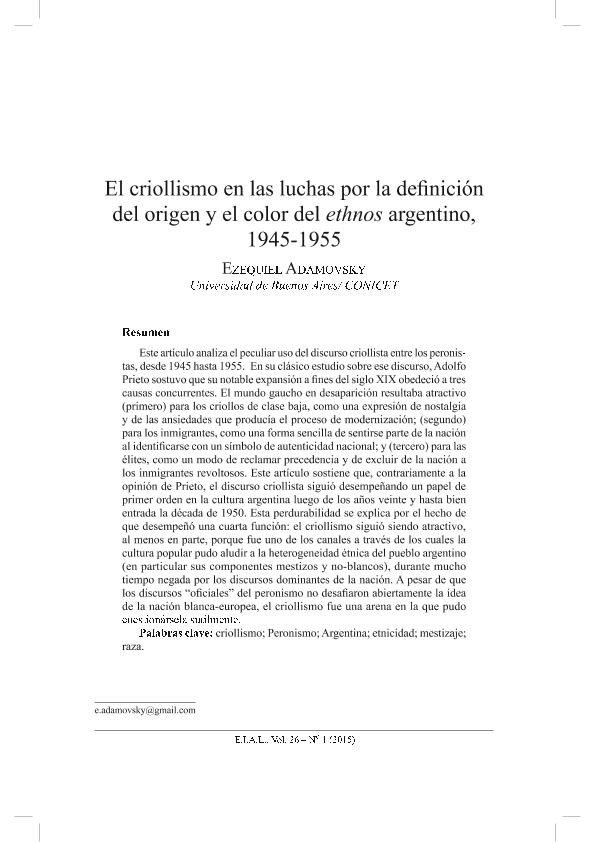Mostrar el registro sencillo del ítem
dc.contributor.author
Adamovsky, Ezequiel Agustin

dc.date.available
2018-05-08T14:40:22Z
dc.date.issued
2015-05
dc.identifier.citation
Adamovsky, Ezequiel Agustin; El criollismo en las luchas por la definición del origen y el color del ethnos argentino, 1945-1955; The Sverdlin Institute for Latin American History and Culture; Estudios Interdisciplinarios de América Latina y el Caribe; 26; 1; 5-2015; 31-63
dc.identifier.issn
0792-7061
dc.identifier.uri
http://hdl.handle.net/11336/44399
dc.description.abstract
Este artículo analiza el peculiar uso del discurso criollista entre los peronistas, desde 1945 hasta 1955. En su clásico estudio sobre ese discurso, Adolfo Prieto sostuvo que su notable expansión a fines del siglo XIX obedeció a tres causas concurrentes. El mundo gaucho en desapariciòn resultaba atractivo (primero) para los criollos de clase baja, como una expresión de nostalgia y de las ansiedades que producía el proceso de modernización; (segundo) para los inmigrantes, como una forma sencilla de sentirse parte de la nación al identificarse con un símbolo de autenticidad nacional; y (tercero) para las élites como un modo de reclamar precedencia y de exluir de la nación a los inmigrantes revoltosos. Este artículo sostiene que, contrariamente a la opinión de Prieto, el discurso criollista siguió desmpeñando un pañel de primer orden en la cultura argentina luego de los años veinte y hasta bien entrada la década de 1950. Esta perdurabilidad se explica por el hecho de que desempeñó una cuarta función: el criollismo siguió siendo atractivo, al menos en parte, porque fue uno de los canales a través de los cuales la cultura popular pudo aludir a la heterogeneidad étnica del pueblo argentino (en particular sus componentes mestizos y no-blancos), durante mucho tiempo negada por los discursos dominantes de la nación. A pesar de que los discursos "oficiales" del peronismo no desafiaron abiertamente la idea de la nación blanca-europea, el criollismo fue una arena en la que pudo cuestionársela sutilmente.
dc.description.abstract
This paper analyses a peculiar use of the criollista discourse among peronists between 1945 and 1955. In this classic study of that discourse, Adolfo Prieto argued that its remarkable expansion in the late 19th. century was the consequence of threee concurring factors. The fading gaucho world appealed (firstly) to the criollo lower classes, as an expression of nostalgia for the past in the face of anxieties brought about as part of the experience of modernization: (secondly) for new immigrants, it was a way to feel part of the nation by identifying with a symbol of national authenticity; an (thirdly) for the elites, it was a way to claim precedence by exluding the rebellious newcomers from the nation. It is the contention of this paper that, contraty to Prieto's assumption, the criollista discourse continued to play a key role in Argentinean culture after the 1920s and well into the 1950s. This endurance is explained by the fact that it served a fourth function: criollismo continued to be attractive, at least in part, because it was one of the channels througn which popular culture managed to allud to the ethnic heterogeneity of the Argentinean people (its non-white and mestizo components in particular), who were longtime denied by the dominant discourses of the nation. Although the "official" peronist discourses did not openly challenge the idea of a white-European nation, criollismo was an arena in which it was subtly undermined.
dc.format
application/pdf
dc.language.iso
spa
dc.publisher
The Sverdlin Institute for Latin American History and Culture
dc.rights
info:eu-repo/semantics/openAccess
dc.rights.uri
https://creativecommons.org/licenses/by-nc-sa/2.5/ar/
dc.subject
Criollismo
dc.subject
Ctnicidad
dc.subject
Peronismo
dc.subject.classification
Historia

dc.subject.classification
Historia y Arqueología

dc.subject.classification
HUMANIDADES

dc.title
El criollismo en las luchas por la definición del origen y el color del ethnos argentino, 1945-1955
dc.type
info:eu-repo/semantics/article
dc.type
info:ar-repo/semantics/artículo
dc.type
info:eu-repo/semantics/publishedVersion
dc.date.updated
2018-05-04T20:13:17Z
dc.identifier.eissn
2226-4620
dc.journal.volume
26
dc.journal.number
1
dc.journal.pagination
31-63
dc.journal.pais
Israel

dc.journal.ciudad
Tel Aviv
dc.description.fil
Fil: Adamovsky, Ezequiel Agustin. Universidad de Buenos Aires; Argentina. Consejo Nacional de Investigaciones Científicas y Técnicas; Argentina
dc.journal.title
Estudios Interdisciplinarios de América Latina y el Caribe

dc.relation.alternativeid
info:eu-repo/semantics/altIdentifier/url/http://eial.tau.ac.il/index.php/eial/article/view/1316
Archivos asociados
